I may sound like I’m being over enthusiastic in this video. I’m not. Everyone who has seen this thinks it is simply amazing.
My father, an ex navy man, has told me stories of glowing water since I was little. Being a person who was obsessed with all things that light up, this always stuck with me. I saw a headline one day that someone was making an algae-light. Sadly when I clicked on it, the algae was just there to create oxygen. It was a cool idea, but not what I was hoping for.
That slight disappointment drove me to create a night light using glowing algae. The process could be extremely simple.
1. Buy Algae.
2. set up light for algae (it needs a 12 hour light cycle and putting it in a window sill would kill it due to heat). It needs bulbs labelled 6500k or higher.
3. shake algae at night (it only lights up when agitated, and when it is on its “night” cycle).
I really wanted to add more to this project though, so I decided to put the algae in a klein bottle and build a custom base for it that would allow me to move a BB around inside the bottle using magnets. This would in turn, hopefully, agitate the algae and make it light up.
I built the base with a DC motor in mind. I dropped it in and added power, but the spin was way too fast and the BB wouldn’t “latch” onto a magnet. I was going to build a small Hbridge to do PWM, but I didn’t have the stuff in my drawer-o-parts and didn’t want to make a trip to the store. So, I stuffed a servo in there instead. It worked, and I thought the BB going back and forth was a cool bonus. You can download the files for the base here.
To get a nice strong light, you have to shake the algae pretty vigorously. I suspected the BB just wasn’t going to perturb them enough to really shine. As a backup, I took one of my kids toys, a “tornado machine” that was basically a water tight tube with a spinning paddle at the bottom. I was right, the tornado machine was much much brighter, but sprung a leak.
The part that is really frustrating is that I just couldn’t catch the effect on video. It seemed bright to my eyes, and a long exposure photo shows it off fairly well, but none of my cameras would get video. I’ve seen videos of this stuff, so I was especially annoyed.
Ultimately, I have moved it to a larger container next to my side of the bed and added some other miscellaneous algae. I tap on it and the result is like a tiny fireworks show in front of my eyes. It is so bizarre and beautiful.
Here’s a .gif I found of the effect. This isn’t my set up, but you can see what I’m talking about here.

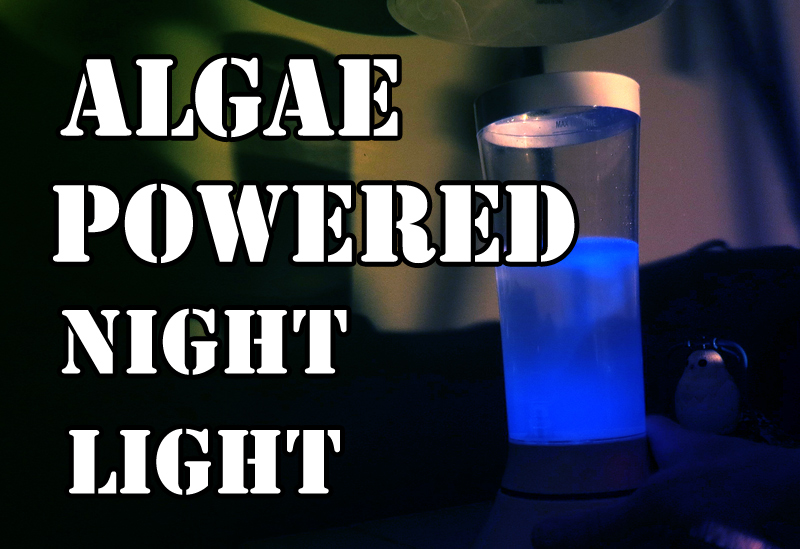
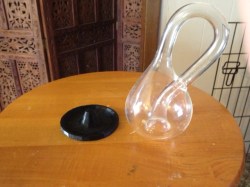
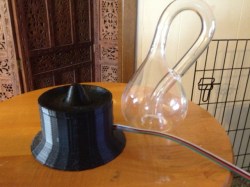
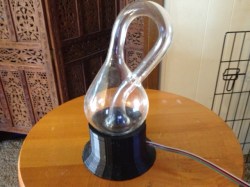


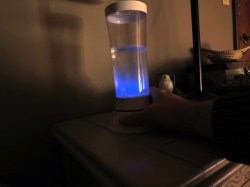















What a cool idea! How long will the algae live?
The website says about a month. They also sell *medium*, which seems to be a sterile properly balanced pH salt solution with nutrients in it. They have kits as well – be sure to check them out.
I’d wager the algae can live a lot longer once you figure out what it needs, given that it has been living in the wild for… well, a long time. There’s a lot of improvements in the technology of hobbiest saltwater aquaria which could probably be brought to bear.
Very neat! Do you need to feed the algae, or just provide light and CO2?
Dinoflagelates have an interesting life cycle with different feeding modes. Red tide is a dinoflagelate which eats fish at certain times.
Can you stimulate the reaction with sound?
Heh – we’re actually trying to do just that at BioCurious. We built a shallow acrylic box, and put a woofer underneath to create standing waves. We’ll probably try it out with teh dinoflagellates next Monday.
What about an ultrasonic foger … if it doesnt kill them
You sure about that? Putting a fingertip on an ultrasound fogger causes pain. I didn’t really look to see if tissue destruction was occurring, but it could be.
Good god proofread your posts, please.
Would putting an old vibrator motor, pager buzzer or something similar ripped out a cell phone & switch in the base not agitate it enough for a nicer light show?
Very cool stuff. Sadly I went to the website and clicked on the $99 “kit” version with the growth medium included along with a few containers and then to the checkout for a shocker. The price was $99, and shipping was over $200. Seemed odd considering the liquid content itself was only 750ml in total. Oh well. STILL very neat stuff.
The shipping is likely because keeping the algae alive during shipping is very difficult. If it gets overheated or too cold it could arrive dead.
It looks like some of their kits have free two day shipping and only the living samples require two day shipping. Perhaps you could place two separate orders?
Have you tried using a “paint shaker” type base that vibrates the whole thing up and down slightly? Or maybe spins the whole thing instead of just a small bb.
One problem is that you can’t shake them *too* hard. The dinoflagellates are fairly sensitive, and will start dying when shaken vigorously.
Even when you shake them fairly gently, they will eventually “run out of light” after a while. They only have so much luciferin they can use for the light-producing reaction, so you really can’t keep them lit up all night.
Awesome !
Now stick a speaker in the night table and make mother nature’s most awesome music visualizer ^^
Hi Caleb,
Why not try an audio oscillator with sub woofer, speaker or possibly an ultrasonic transducer to see if any particular frequency range causes the most light to be emitted..
This isn’t caleb’s hack. He’s just responsible for the numerous spelling errors.
Does anyone know where I can get this stuff in Europe?
Have you tried the North Sea?
http://www.ccap.ac.uk/results.php?mode=basic&strainsearch=Pyrocystis
What about using a small airstone, or air bubbler curtain, is there a danger of absorbing too much co2 into the water? could even slow down the airpump to cause just a pulse now and then. (or many aquarium shops have bubbler animated features. such as treasure chests that fill with air and then open spilling out a big bubble and then closing again.
Came to say this… I think I may need to build one of these setups soon.
What about just modifying your original stand’s servo for continuous rotation. You should be able to achieve a similar effect to the tornado bottle.
An aquarium air pump, with clear tubing would be great for agitating the algae. It could turn on periodicly for a second using a relay and an arudino
Light wise Id buy cree leds, run them on an arduino with a driver and dim them up and down and maybe to flash the algae to wake them
Photoplantion thats used for reef aquariums might keep the algae alive or “green water” which they use to keep brine shrimp
just a little warning: it’s extremely difficult to maintain algae in a monoculture. Other algae and diatoms ( a.k.a. brown algae) get introduced into the system very easily and can take over, outcompeting yours for nutrition. That’s probably why they’re a bit pricey. Befriend an experienced aquarium enthusiast or two, preferably one who breeds Neocaridina shrimp – they feed on algae.
There’s also bioluminescent mushrooms that you can buy as spore culture. You don’t need to shake those ;)
I have thousands of neocardinia. I’m a freshwater aquarium nut, and invertibrates are my favorite. I’ve never heard of people growing dinoflaggelates for their shrimp… ever. People grow moss for their shrimp, and will get shrimp to help cut down on freshwater algae, especially hair algae.
I didn’t mean to suggest them as food for the shrimp, but that shrimp owners know a thing or two about maintaining a balanced system, cycling water, keeping unwanted stuff out and spotting problems from day one. You kinda illustrated my point.
AFAIK Neocaridinas don’t consume moss, but comb them for the algae that grow on them.
Anyhow, good to hear they’re in good hands. If a freshwater aquarium nut fails to keep them in cultivation none of the folks here will.
sadly, though I’m obsessed with freshwater, I haven’t done ANY salt. It is a strange world and I could easily kill these guys. Add on top of that the fact that 99% of the salt water hobby world is obsessed with KILLING their algae instead of cultivating it. It is peculiar place to be.
oh, and yes, the shrimp generally do comb the moss for algae, you’re right. Neocaridinia aren’t great for removing algae blooms because they eat so very little, but I love the little goons.
Ouch, yeah that’s a bummer. Currently on mobile, didn’t look it up – thought they were freshwater. Apparently not a lot of luciferase in the freshwater world. These two links might brighten things up, though:
http://www.bioluminopedia.info/apps/blog/show/3086162-crustaceans-lights-the-way-strange-but-true-
http://www.bioluminopedia.info/apps/blog/show/3050879-culturing-bioluminescent-microbes
You can get the mushroom kits at Black Jungle Terrarium Supply http://www.blackjungleterrariumsupply.com/Bioluminescent-Glow-in-the-Dark-Mushroom-Habitat-Kit_p_1965.html
I may have to do this. Maybe not for a video, but just because WOW.
I know, right? It’s on my list of projects to do. The guys at Black jungle are cool too, I bought dart frogs from them when they had their shop in Vegas.
no, seriously, I’m ordering a kit to go in my overgrown riparium RIGHT NOW.
Seems to be referred to on wiki by foxfire: http://en.wikipedia.org/wiki/Foxfire quite interesting…
Caleb: Did u ever get the biolume mushrooms? How’d they work out?
Yeah – the glow mushroom kits are cool. U can get them here: http://www.blackjungleterrariumsupply.com/Bioluminescent-Glow-in-the-Dark-Mushroom-Habitat-Kit_p_1965.html
Zeevonk (Dutch for Sea Sparkle) is a common algea in the North Sea (http://en.wikipedia.org/wiki/Noctiluca_scintillans).
A few hints from a biomolecular hacker: Using an airstone will provide MUCH more agitation, the issue being keeping things sterile. Two quick hacks I’ve used in the past are using Whatman syringe filters on the input (0.2 um, work as well for air as they do for filter sterilizing liquids) and Tyvek…tyvek isn’t as foolproof, but bunches cheaper and allows you to make filters of different sizes. You also should learn about aseptic technique and build a glovebox for you’re experiments into the microbe realm; the latter is really simply an airtight box that allows you to wait for all particles to settle onto freshly sprayed walls (soap water works well, as does a dilute bleach solution). Both of these are also good to know if you want to delve into the realm of luminescent fungi.
You could set up a miniature “fish tank” to see if you can prolong the life or encourage replication to make a longer lasting system…. Yes, a lot more complicated than the simple idea!
Yes I vividly remember the trip to Jamaica and the luminous lagoon.
That was great. You could see the outline of fish and the wake of the boat was really bright. They encouraged you to bring a clean water bottle, Not a soda bottle. and fill it with the water and it lasted for 3 days.
BTW I placed an order for a spore kit to put in my Terrarium.
Sounds easier to fake it with a blue highlighter and some UV Led’s….
I think you’re right. “Synthetically” reproducing the effect would probably be easier, but I think the organic aspect was important to the author.
would be even easier to turn on the light. But I wanted glowing algae, so that would be completely missing the point.
oh man I have wanted to do this for years I hope you can find a way to keep them alive longer. I want to do this so bad, I just cant bring myself to spend that much money on it if it will only last a month. So fucking awesome, yet so disappointing
do they not reproduce? why dose the colony die off so fast?
“Cultues of bioluminescent algae can persist indefinitely if periodically diluted with new growth medium.” – from the website
That’s what i wanted to hear. They live a month without maintenance
AND its like $20 for the “growth medium”
Not gonna lie, this is probably my favorite hack a day post ever. I learned about bioluminescent algae a while ago and wanted to do this exact thing, but I couldn’t find a source for the algae so it never went anywhere. Now I get to learn how to keep algae and make a nice tank for them. Sweet!
Could you link to the microalgae food you got as well?
What would happen if you feed them to some fish with clear skin, would the fish glow in the dark? I’ve been wanting to try that with some glow in the dark pigment mixed with fishfood.
Theoretically yes…I guess? I think the problem with the algae is that it probably stops the process if killed.
Oops forgot. Somewhat related image with transparent ant bellies: http://www.clusterflock.org/wp-content/uploads/2011/08/transparentantscolored.jpg
That’s super cool, I imagine they’d look great with some sub-woofer action. Might look in to getting something set up if there’s a cheap option.
Another interesting and parallel subject is fluorescent proteins. They have been added to a lot of living objects by human hand. Here’s a glowing cat: http://www.bbc.co.uk/news/science-environment-14882008
Nice work! We’ve been working with these dinoflagellates in our Bioluminescence group at BioCurious for a while, and actually handed out 250 vials to people who dropped by our booth at Maker Faire last year. Turns out you can easily grow them on salt water with a few drops of MiracleGro plant fertilizer. Here’s a link to our “Care & Feeding” page we set up for the occasion:
http://tinyurl.com/mypetdinos
Also check out the instructable we wrote a while back on another light sculpture we built to show off the dinos:
http://www.instructables.com/id/The-Light-Fountain-a-Bioluminescent-Hourglass/
Patrik
The idea I instantly had wrt to your bum container was tygon tubing! Pump it around the room like biological EL wire!
Might be really cool if the little guys were more reactive to pressure. The tubing idea coupled with a subwoofer piping throughout the room.
My first thought is put the little buggers into a rig like this filled with their salt water.
http://hackaday.com/2012/04/06/displaying-bubbles-in-mineral-oil/
And my second thought is could you activate them (without killing them) by running a small electric current through the water? (Now that’s a lightbulb!)
What impressed me is that he put something in a Klein bottle.
What impressed me is your lack of understanding of a klein bottle, A. it has no ‘inside’ (it is non-orientable) B. To put liquid into a 3d-projection of a klein bottle you just pour it into the ‘spout’ (usually on the bottom)
What impressed me is your lack of understanding of a joke, and the irony of your pompous reply.
Neat idea, would have been awesome with a video of the algae in action though!
sooo, yeah…. im gonna be that guy…… was it just me or did he say dino flatulence?
Very cool. I’ll have to get some. We were doing a project at work and were provided some blue-green algae(fresh water) and other than bubbling air in at a slow rate and periodically adding water, those suckers would not die! Lasted for months. Guess the prettier ones are more temperamental.
I’m fascinated with the idea of pet algae. Anyone doing that?
I’m very fascinated with the idea of algae as pets… is this a hobby?
I’m sort of surprised that none of you mentioned using an old magnetic stirrer as the agitating element. I’ve got an old one in the shop that works quite nicely. It’s just an AC motor with a rheostat to control voltage to the motor (controlling the voltage translates into controlling the speed), with a alnico bar magnet mounted perpendicular to the motor shaft.
we did actually. That is what the klein bottle system was based off of, as I mentioned in the video.
How are your algae doing Caleb? I found some people saying constant disturbance can over stress them. They seam to survive crashing breakers in the wild though?
Mine will be here tomorrow, I’m building a big wave machine to hang on the wall
Found an instructable
http://www.instructables.com/id/Grow-Your-Own-Bioluminescent-Algae/#intro
I have had a lot of success culturing Pyrocystis with this concentrated culturing medium from Carolina Bio Supply. The price has gone up recently, but it’s still a good buy.
http://www.carolina.com/biological-media-ingredients/alga-gro-concentrated-medium-pack-of-12-tubes/153751.pr
Just a heads up. I found the algae for a bit cheaper (for larger orders) and with more options here: http://seafarms.com/html/products.html
Fantastic Hack, To keep it lit maybe try a small aquarium power filter without media such as the AquaClear 20 Power Filter. These are cheap, transparent plastic, quiet, adjustable flow, magnetic drive, units. Certain you could hack something together with these that would agitate with out adding extra noise or air to the mix.
How about a length of fishing line suspended from above and attached to the magnet at the bottom of a jar? I envision an “aurora sheet” or a “lightning bolt” effect as the fishing line cuts through the liquid.
I’ve never seen this stuff before so I could be way off.
If you could find a cheap magnetic stir plate, you could mix by putting in a stir bar (magnet coated with teflon or PETE) and putting it all in the flask or vessel of your choice.. That is how we keep cultures aerobic in microbiology labs.
I had an idea for a stage effect using dinos. I remember long ago visiting a beach in Santa Cruz while the algae was running, and picking up a piece of kelp leave and chafing it with my thumb to make the algae that was on it glow. Suppose one had some dinos in a spray-bottle and spritzed down a shirt lightly with them. Then you scrape your hand across the fabric to agitate it. It probably would not last long, but long enough for the purpose. And of course there’s the ethical dilemma of utilizing a living being simply for a special effect. But setting that aside for another discussion, do you suppose this would work?
would be wondering if you help me if you know about algae lamps please give me detail about it and answer my questions This is my questions?
how the algae will charge the battery in day?(process)
how the algae will take his energy from the battery in night?(process)
is algae able to fill the battery?
is the algae’s glow as the lamp we use?
how long the lamp can stay without repairing?
how the algae will stay in life in a cold or hot place? I think it needs a particular temperature
how can we connect the 30 nanometre-wide gold electrodes to each cell of liquid algae ?
please respond on my emai
1) The algae does not charge batteries.
2) The algae will not take energy from batteries.
3) The algae will not fill a battery.
4) The algae glow is not as bright as a standard lamp.
5) ?
6) The algae lives in the sea in various places around the world. Depending on what
algae culture you have and where it came from would depend on temperature.
7) You can’t.
Hello everyone. I’ve been wanting to do this for years, but the problem is it’s almost impossible to get anything bioluminescence in Europe, let a loan in the UK :( Shipping to the UK from the the US is $200:-( I have looked every where for years and the only places that have bioluminescence alage are research labs and they will not sell unless I’m a university or another lab:-( I can acquire everything else apart from the main ingredient which is the alage. This just silly, there is cleanly a demand for bioluminescence in Europe. So why is no one supplying it. Could be a good business opportunity. Can any of you good people help a poor English man enjoy the wonder and delight of bioluminescence alage? Do any of you know a place in Europe or better still the UK? Or would it be possible one of you could sell me some bioluminescence alage? I wait with eager mind for your replies. Thank You.
FINALLY
A supplier in the UK.
http://www.ccap.ac.uk/results.php?mode=basic&strainsearch=Pyrocystis